After a decent nights sleep, I woke up on Wednesday, March 22nd (yes my blog is over a month behind but I’m going to catch up I promise!), had breakfast, then had the desk call a taxi. The North Bus Station in Cebu City is about the same distance from Kiwi Lodge as the South Bus Station. A short ride to the bus station and then I was on a bus headed to Maya. 5 hours later we arrived at the pier in Maya.
At Maya the bus lets you out at the new pier. You’ll be asked to log in with the tourist association, then you will purchase a ticket. Price of a ticket on the ferry is a 100 pesos. When the boat was ready we were directed to the boat and someone took our tickets. Be prepared to wade through the water (usually not more than ankle deep) to a ramp to get up on the boat. About 35 minutes later we were walking off the boat at Bounty Beach.
I should add here that last year when I spent 4 weeks on Malapascua Island that I came and went 4 times. Only one of those times did the ferry go to Bounty Beach. When I was in Malapascua again a couple of weeks ago, we were also dropped off at Bounty Beach so perhaps this is something new. What was more normal last year was to go to the port and if it were low tide, a small boat would transport us for 20 pesos. Again, be prepared to get your feet wet.
I opted to stay at Purple Snapper which is under new management and ownership. I knew from having stayed there last year, that the rooms were much more inexpensive than anything I would find on the beach! When I arrived I discovered everything was in the process of being changed over, including the name which has been changed to Sharks Tail. Interestingly enough, I again ended up in the same room that I’d stayed at on my last visit when I stayed for 4 weeks last April. As I’ve said in other blog posts, I often will get the least expensive room. This usually turns out to be a fan room with no television in some places.
Unlike my last trip, the bar and kitchen were open this time, and there was water in the swimming pool! Last year the pool was empty! I met Greg, the new manager, and it sounds like they’re really going to do a lot with the place.
Although I was offered the opportunity to dive with Shark’s Tail, I opted to dive with Evolution. Nothing against Shark’s Tale, but I’ve been diving with Evolution since 2010 and don’t feel any need to go somewhere else. I’ve been very happy with their operation which I consider to be a very professional one.
I was in Malapascua again just over a week ago and have done over 80 dives with Evolution now. At present I’ve done over a 100 dives in Malapascua. I made my first dive there in October 2007. I’ve not gone every year, but I have made six trips now… there must be some reason I keep going back!
This trip I was only planning 3 dive days. I was exhausted after the long bus ride so I opted NOT to get up early for the shark dive. Instead there was trip going to Kalanggaman Island the next day and of course I signed up!
Kalanggaman Island technically is in Leyte so it’s a bit of boat ride to get there. It’s an all day trip. It leaves around 9 AM and takes an hour and a half to two hours to get there, depending on weather of course. There is an extra fee involved of course because of the long boat ride, 650 pesos, which also included lunch. There is also a Marine Fee charged by the Leyte government of 500 pesos, so yes you are paying an extra 575 pesos per dive (don’t forget lunch is included though). I always try to go to Kalanggaman every time I visit Malapascua though. The diving is just that amazing!
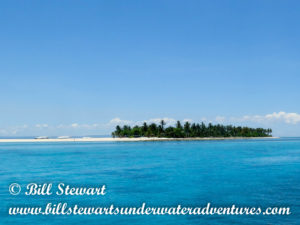
Kalanggaman Island is wall diving for the most part. You drop in over a sandy area, then swim over the wall and descend from there. Visibility is often well over 50 feet to as much as a 100 feet!
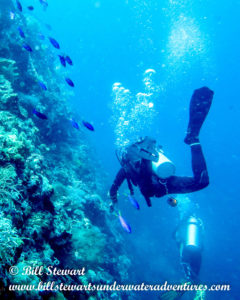
After a good nights sleep and breakfast at The Craic House (Evolution Dive Resorts restaurant), we had our briefing at 8:45 AM. By 9 AM everyone was on the boat and we were underway.
I always try to sit in the middle of the boat. I’m one of those people who just cannot get a tan it seems. I can get very red though! It was a nice relaxing trip. The weather was absolutely beautiful! As we were approaching the island a pod of dolphins was spotted and the boat briefly followed them. Sometimes dolphins seem to want to play and will race along in front of the boat, with occasional leaps into the air, like they are just having fun with us! Today though they seemed to have other things on their agenda so we continued on to the island.
At 10:55 we were starting our first dive. Our guide was Mette Hallum who is a dive instructor from Denmark. I actually have a photo of her from a dive on Monad Shoal last year. Right at the beginning of the dive there was an eagle ray hanging out near the mooring line and I took several photos of Mette shooting video of an eagle ray with her GoPro.
I’m never disappointed when I dive Kalanggaman. Visibility was easily 50-60 feet. Right at the beginning of the dive Mette spotted a black frogfish. I never seem to get tired of photographing frogfish! There are loads of hard and soft corals at Kalanggaman Island and they are in good shape. You can see schools of jacks and rainbow runners. Lots of wrasse and damselfish. Scorpionfish, frogfish, nudibranchs, triggerfish, parrotfish, schools of anthia’s, hawkfish sitting on coral, just waiting to swoop somewhere, coleman shrimp, anemonefish, ghost shrimp, butterflyfish,… all the “usual suspects” as I’m prone to call them. Water temperature was 78 degrees Fahrenheit and my maximum depth ended up being 88 feet. The dive ended up being 44 minutes.
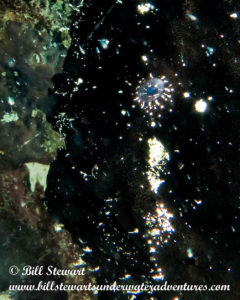
During the surface interval we pulled in too shore and had lunch. After lunch we were able to get off the boat and walk around the island. There are a few basic facilities there, but no water or food. You have to bring your own. I walked around the island a bit and snapped a few photos then back to the boat. The boat pulled out again and we headed to do our second dive.
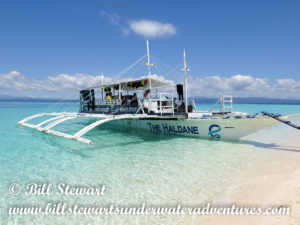
I started the second dive at 1:28 PM. We again were diving the wall, but a different area than the first dive. Pretty early in the dive Mette found an ornate ghost pipefish next to a crinoid which I took several shots of. The rest of the dive was much like the first one. Lot’s of fish, anthia’s, damselfish, more hawkfish, a couple of different white-eyed moray’s… just another awesome dive! Maximum depth on this dive was 66 feet. Water temperatures were a bit warmer at 80 degrees Fahrenheit, since we didn’t go quite as deep as the first dive. This dive was 56 minutes.
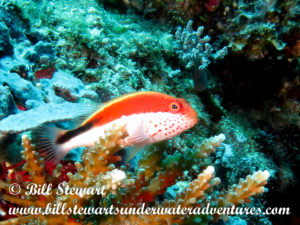
After everyone was back on board, we got underway and headed back to Malapascua Island. We arrived at Evolution Dive Resort before 5 PM. I checked out the board for dives that were scheduled for the next day. I had planned a full day of diving for the next day, but trips to Gato Island require a minimum of four divers. I’d let it be known that I really wanted to dive Gato Island and it had been put on the board before we left that morning. I was happy to see there were enough divers. I signed up to do the early morning Thresher Shark dive at Monad Shoal and also the night dive at Pipefish Bay. After dinner at Craic House, I headed back to Sharks Tale for some rest. It was going to be a long day the next day!
The big draw that Malapascua Island has for most people is thresher sharks. It’s the only place in the world where recreational divers can see them on a reliable basis. Is it a 100%? No of course not and no reputable dive operation should promise that. We’re still dealing with a wild animal and conditions, especially current can affect sightings. Having said that, I’d estimate that over 80% of the dives I’ve made on Monad Shoal, I saw thresher sharks. Another way of looking at it would be in a one month period there might be a half dozen or so days when no sharks or sighted which means you’re much more likely than not to see sharks!
Monad Shoal is an underwater island that is actually larger than Malapascua. Scientists currently believe that thresher sharks migrate to the area of Monad Shoal to utilize the services of particular species of cleaner fish that are found there. It’s about a 40 minute boat ride depending on conditions. You have to get up early to see thresher sharks. Early morning is the only time when sightings are consistent. The species that is seen here is the pelagic thresher shark (Alopias pelagicus).
Dive briefings at Evolution for the morning trip to Monad take place at 4:45 AM. The staff and boat crews are there much earlier making preparations and loading all the gear on the boat. Divers who have already been diving will grab their wetsuits. Wetsuits are always hung up separately from the gear to allow them to be at least somewhat dry from the previous days diving. It’s easier to let divers find their own wetsuit where it’s hung up. It would be difficult for the crew to know which is which since they’re hung up together, especially in the dark! Once the briefing is over everyone will be transported by small boat (it’s low tide in the morning) out to one of the large bangka boats for the trip to Monad.
I was up at 4:15 AM the next morning. I give myself enough time to wake up in the morning and get my camera gear set up. The walk to Evolution is only about 5 minutes, so not far at all. When I got there I grabbed my wetsuit and then sat and waited for the brief. The brief was given right on time at 4:45 AM. One of the rules is that if you don’t show up for the brief, then you will be charged for the dive. This is just to make sure that people don’t blow off the dive. The crew comes in early to load the boats so there is a lot of work to be done in preparation to go out. Having said that, as long as you show up, if you decide that you are not up to a dive that day, or want to call the dive for any reason, you can do so and there will be no charge.
As soon as the brief was finished, we headed to the beach where a small boat took us out to the Haldane, one of Evolutions dive bangka’s. It’s still dark outside at this point, but we can see a hint of light off to the east. Once on the boat, a boat brief is given for everyone who is on the boat for the first time. Everyone checks their boxes to double-check that there gear is all there. People are human, so things can get mis-placed, although in my experience, having dived with them for years, this is extremely rare. Always best to err on the side of caution. No one wants to get out to the dive site and not have all their equipment. The tanks are normally already set up and I double check mine. After all, I’m the one who is diving with it! After that I go and make myself a cup of coffee and sit in the back while the boat gets underway. By 5 AM we were on our way to Monad Shoal.
As we approach Monad Shoal everyone starts getting ready. People put on their wetsuits and booties, strap on dive computers, apply de-fog (or spit for all the old-school divers), and stage mask, fins, camera’s, etc… By now there is plenty of light as the sky brightens with the arrival of sunrise. Within minutes of arriving at Monad, the crew assists divers with their tanks, final checks are completed and divers start stepping into the water with a giant stride entry. I was in the first group. Our guide this morning was Alex, one of Evolution’s Filipino guides. I’ve been diving with Filipino guides for almost 10 years now and they have always impressed me with their skills. Evolution has some of the best guides I’ve had the pleasure of diving with over the years. I’ve often said that almost everything I learned about spotting, I learned from my Filipino guides!
I stepped in, was handed my camera by a crew member and then finned over to Alex while we waited for the rest of our group. Once we were all together, Alex got a final ok from everyone, then a thumbs down for descent. I dumped the air from my wing and my dive began at 5:47 AM.
The best word to describe Monad Shoal at this time of the morning is “twilight”. By now there is enough light in the sky that you can see quite well, but it is far from “bright”. The top of the shoal slopes and is at about 60 feet on the shallow side. The slope continues down to over 80 feet. Around the edge of the shoal it drops off into over 700 feet of water. Visibility runs 30-60 feet depending on time of year and conditions. Where we started our dive it was about 60 feet deep. When I started to drop, I could not initially see the bottom, but it came into view very quickly. There are permanent mooring lines attached at different places. If there is current then you can use the mooring line to descend. This morning current was almost non-existent.
For most of the dive there were no sharks… this happens sometimes. Nothing is exact when it comes to predicting when they will be there. Sometimes we see them briefly, sometimes we see them the whole dive, and occasionally the sea gods are against us and we don’t them. Still, for me there really isn’t any such thing as a “bad” dive. As I said before there is plenty of life there on the shoal. I spotted a free swimming moray early on in this particular dive. Something you rarely see in full daylight conditions. There are also the usual marine life that you would see, anemonefish, damselfish, batfish, jacks, cleaner wrasse, shrimps, crabs, etc… All the “usual suspects” that those of you who follow my blog have heard me refer to them as.
One of the “rules” agreed to by all the dive operations on Malapascua Island, is that divers will not take lights are strobes on the morning thresher shark dive. There is a concern that if that was allowed, that the sharks might be scared away, and of course no one wants that! So, although I do often see other marine life, I rarely photograph it during that dive. At that depth and under those lighting conditions everything tends to be very “blue”! Sometimes in post-processing I convert to black and white because of that, and sometimes I leave it blue. It kind of depends on how I’m feeling at the moment!
When there are no sharks, I sometimes entertain myself by photographing the other divers. I usually want a few shots of divers anyway. My background in photo-journalism drives home the point that divers are a part of the “story” here and they really are. Diving is so much better when we have someone to share the experience with! I sometimes also will take the time to look at the other life on the shoal. I spend most of though like everyone else… looking for sharks!
At Monad there are a number of observation stations that have been set up. There are concrete blocks that have been sunk there and line attached. This is to give the sharks room to approach on their own. Again, if there were no organization here, and with so many divers in the water, there could be a possibility that the sharks would go elsewhere. During the morning dive when there are so many divers there, groups are to confine themselves to areas behind the lines. If no sharks are appearing at one viewing station, then a leisurely move to another station is allowed. Just keep away from the edges and behind the area where the lines have been installed. This maximizes sighting opportunities for the majority of divers. The system must work… as I said earlier seeing sharks is easily 80%! It’s important to understand though, that sharks can approach from any direction, occasionally they even come from behind you!
This morning, as luck would have it, we just weren’t seeing sharks. It happens…. Towards the end of the dive we had returned back to the area of the mooring line and a little beyond it, when Alex spotted a thresher shark in the distance in front of us, coming towards us! The shark swam right by me and I was able to take a few still photos, then switch to video. The shark went by, circled back a couple of times, then was gone into the blue. Awesome!
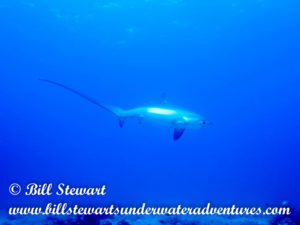
Back on the boat everyone was all smiles! People were talking, the photographers were sharing their photos and video’s, and it’s just general happiness, especially from those who have traveled from half-way around the world and sometimes only have a brief few days. Does life get any better? I ended with a 43 minute dive with a maximum depth of 77 feet. Water temperature was 79 degrees Fahrenheit.
We headed back to Evolution. I gave my camera gear a quick rinse, then headed to the restaurant for breakfast. I ordered, then dried off my housing so I could remove the camera and download photos from the morning dive. By 7:35 my breakfast was in front of me. After breakfast, I relaxed until it was time for the briefing for Gato Island at 9:45 AM. By 10:00 AM we were back on the boat and headed to Gato.
To be continued…
I hope you enjoy reading my blog. If you have, don’t miss my next post! Visit the “Subcribe” page and sign up now. It only takes a moment. Lot’s more coming! 🙂

